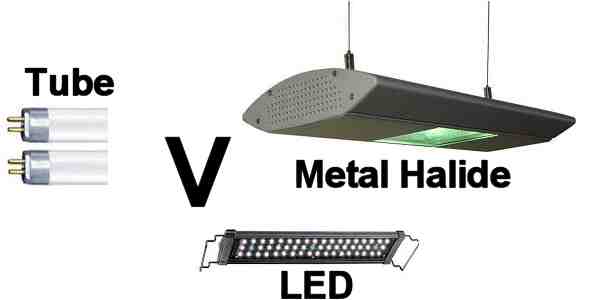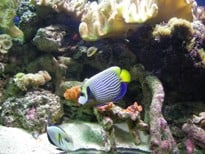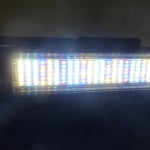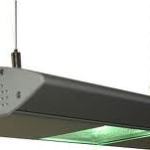The type of lighting that you choose for your aquarium really depends on the job it needs to do. There is a huge range of styles to choose from, to suit all types of aquarium and budget, and if you’re new to the hobby, it can be a little overwhelming.
 In an aquarium with just fish or plants requiring little light, a light source is just for viewing and enhancing natural colours. A good warm light will enhance the natural beauty of tropical fish and make the very best of your fish tank. For example some lamps will enhance the reds and pinks within a tank, or reflect the natural blues and greens.
In an aquarium with just fish or plants requiring little light, a light source is just for viewing and enhancing natural colours. A good warm light will enhance the natural beauty of tropical fish and make the very best of your fish tank. For example some lamps will enhance the reds and pinks within a tank, or reflect the natural blues and greens.
If however, you have a planted aquarium or reef tank, then the light not only needs to provide a perfect view but also promote photosynthesis, so will boost beautiful plant and coral growth. Replicating the natural habitat of the plants will aid growth and vitality, so it’s important to look into the correct kind for your tank. A good reef light will also reflect the natural fluorescence of corals and invertebrates too.
 Most reef and planted aquarium lighting uses a Kelvin rating which denotes the colour temperature. For example a Kelvin rating of around 6,500K simulates a natural sunlight, whereas a high temperature of around 20,000K is a powerful pure light that promotes coral growth.
Most reef and planted aquarium lighting uses a Kelvin rating which denotes the colour temperature. For example a Kelvin rating of around 6,500K simulates a natural sunlight, whereas a high temperature of around 20,000K is a powerful pure light that promotes coral growth.
It’s important to control the amount of light in your aquarium. Left on for too long, and you can find yourself with an algae problem. A rough guide is about 7-9 hours of light per day is ideal for the best results. A timer is a good idea too, in case you aren’t around to monitor it. Swell UK have a wide variety of all types of aquatic lighting and accessories to suit every aquarium, big or small.
With that in mind, it’s worth looking at the various forms of aquarium lighting and weighing up the various positive and negative attributes of each:
Fluorescent Lighting
Fluorescent lighting in the form of tubes is the most common type of aquaria lighting. T8 and T5 tubes sit in a light unit or in the hood above the tank. T8 is the older type of fluorescent tube, and available in various formats for different uses. T5 tubes are the newer version. Slimmer and more compact, they last around 25% longer and emit a brighter light.

Pros:
- This type of lighting is easily available.
- It’s much cheaper than other types too, making it more affordable.
- The light emitted provides great viewing as well as an ideal boost for plant growth.
- Various formats are available for all types of aquarium
Cons:
- This type of lighting can emit heat, so a chiller may be required.
- It’s not as long lasting as more modern sources of lighting either, so may need replacing more often.
- Unlike LED or Metal Halide lighting, it does not shimmer in the water.
LED Lighting
An advance in aquatic lighting, LED (Light Emitting Diode) lighting is a great addition to the market. It is available in various colours to reflect the natural hues of tropical, fresh and reef life. It creates a very pure, penetrating light that can massively benefit both planted and non-planted aquariums. Several different formats are available from modular units that you can create yourself, to advanced

Pros:
- LED lighting has been found to be more energy efficient than standard forms of lighting.
- It lasts a long time too, saving time, power and money.
- LED light emits very little heat emit so you won’t need a separate chiller.
- It’s available in various colours to both enhance and flatter the authentic colours of fish and plants.
- It also recreates the natural shimmer effect of light in the ocean.
Cons:
- Compared to standard forms of lighting, it can be an expensive outlay initially.
Metal Halide
A relatively new addition to aquarium lighting, metal halide lighting is a powerful source. It is created by a fusion of mercury vapour and halide salts. A general idea is that a metal halide bulb with a colour temperature of 5,500-6,000K replicates natural sunlight, so it’s ideal for freshwater aquariums. A reef tank usually requires a much higher rating, of around 10,000 to 20,000K, this is perfect for coral and invertebrate vitality and development.

Pros:
- A pure white light is produced that, like LED lighting, penetrates deep into the tank, providing a natural shimmer throughout the water.
- It uses little energy
- It is long lasting, so it will not need replacing too often.
Cons:
- Bulbs can be a high initial outlay, and the actual light units can be costly too.
- Metal halide lighting also produces heat, so a chiller might be required.
Of course, we all want to save money, but in the long term it may be more beneficial to spend a little more at first, for a longer return. Of course, how long a light source lasts depends on the actual amount of time that it is used for. For the best results, spend time researching and planning to ensure you can see your tank in the best light, literally.


Related Posts
A Deeper Look In To Loach Fish Species
How Much Salt Should I Add To My Freshwater Aquarium
Everything You Need To Know About Using T5 Lights For Your Aquarium